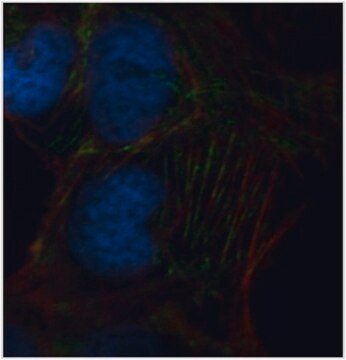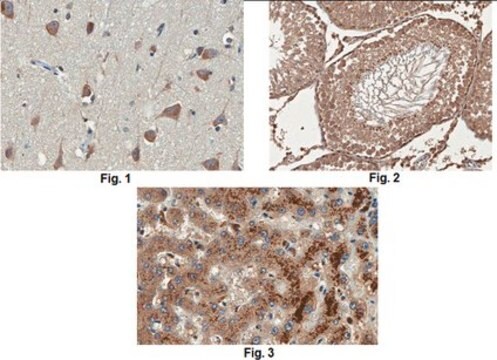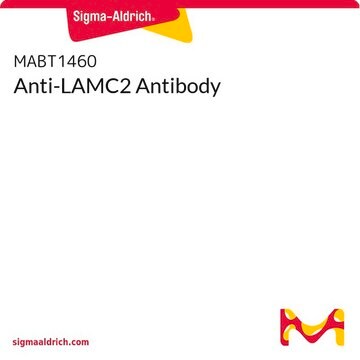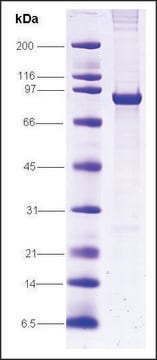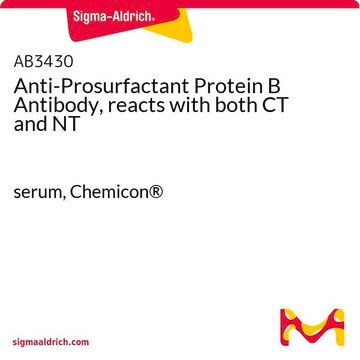MABS1221
Anti-GLEPP1/PTPRO Antibody, clone 5C11
clone 5C11, from mouse
Sinónimos:
Receptor-type tyrosine-protein phosphatase O, Glomerular epithelial protein 1, Osteoclastic transmembrane protein-tyrosine phosphatase, Protein tyrosine phosphatase U2, PTP-OC, PTP phi, PTP-U2, PTPase U2, R-PTP-O
About This Item
Productos recomendados
origen biológico
mouse
Nivel de calidad
forma del anticuerpo
purified antibody
tipo de anticuerpo
primary antibodies
clon
5C11, monoclonal
reactividad de especies
human
no debe reaccionar con
mouse, rat, rabbit
técnicas
electron microscopy: suitable
immunofluorescence: suitable
immunohistochemistry: suitable
isotipo
IgG2bκ
Nº de acceso NCBI
Nº de acceso UniProt
Condiciones de envío
wet ice
modificación del objetivo postraduccional
unmodified
Información sobre el gen
human ... PTPRO(5800)
Descripción general
Especificidad
Inmunógeno
Aplicación
Immunofluorescence Analysis: Prior to purification, clone 5C11 hybridoma culture supernatant detected GLEPP1 (PTPRO) immunoreactivity predominantly on visceral glomerular epithelial cell (VGEC) foot processes along the glomerulus (GBM) in manthanol-fixed, adult human kidney cryosections, while altered GLEPP1 staining patterns were seen in kidney sections from individuals with congenital nephrotic syndrome of the Finnish type (CNF), minimal-change nephropathy (MCN), or Hodgkin’s disease (Sharif, K., et al. (1998). Exp. Nephrol. 6(3):234-244).
Electron Microscopy Analysis: Prior to purification, clone 5C11 hybridoma culture supernatant detected GLEPP1 (PTPRO) immunoreactivity at the apical aspect of the foot processes and the cell membrane of larger processes in paraformaldehyde-fixed, paraffin-embedded normal human adult kidney sections, while GLEPP1 immunoreactivity was seen redistributed from glomerulus (GBM) on the apical cell membrane of VGECs to microvilli on kidney sections from individuals with congenital nephrotic syndrome of the Finnish type (CNF) or minimal-change nephropathy (MCN) (Sharif, K., et al. (1998). Exp. Nephrol. 6(3):234-244).
Calidad
Immunohistochemistry Analysis: A 1:50 dilution of this antibody detected GLEPP1/PTPRO in human kidney tissue.
Descripción de destino
Forma física
Otras notas
Not finding the right product?
Try our Herramienta de selección de productos.
Código de clase de almacenamiento
12 - Non Combustible Liquids
Clase de riesgo para el agua (WGK)
WGK 1
Punto de inflamabilidad (°F)
Not applicable
Punto de inflamabilidad (°C)
Not applicable
Certificados de análisis (COA)
Busque Certificados de análisis (COA) introduciendo el número de lote del producto. Los números de lote se encuentran en la etiqueta del producto después de las palabras «Lot» o «Batch»
¿Ya tiene este producto?
Encuentre la documentación para los productos que ha comprado recientemente en la Biblioteca de documentos.
Nuestro equipo de científicos tiene experiencia en todas las áreas de investigación: Ciencias de la vida, Ciencia de los materiales, Síntesis química, Cromatografía, Analítica y muchas otras.
Póngase en contacto con el Servicio técnico

